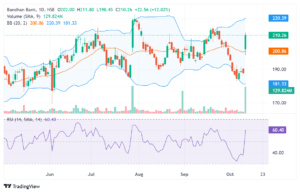Bandhan Bank is a unique financial institution in India that has grown from humble beginnings. It started in 2001 as a not-for-profit organization focused on financial inclusion and women’s empowerment. Over the years, Bandhan Bank evolved into a major player in the Indian banking sector. The bank’s journey from an NGO to a Non-Banking Financial Company (NBFC) and, finally, to a full-fledged bank in 2015 has been marked by its mission to serve the unbanked and the under-banked. This article provides a detailed look at Bandhan Bank’s history, performance, and current financial standing.
History and Evolution
Bandhan Bank began as an organization dedicated to financial inclusion. The goal was to provide small loans to women and poor communities to help them generate sustainable livelihoods. Its primary focus was on people who did not have access to formal banking services.
In the early years, Bandhan functioned as a microfinance institution (MFI), which meant it offered small loans to those in need without requiring collateral. Microfinance institutions are important in emerging economies, as they help individuals start small businesses and improve their financial situation.
With the success of its microfinance operations, Bandhan transformed into an NBFC to expand its services. This change allowed it to manage deposits and offer loans to a wider range of customers. In 2015, Bandhan received the universal banking license from the Reserve Bank of India (RBI), enabling it to offer a complete range of banking services.
On August 23, 2015, Bandhan Bank officially started its operations. From that point, Bandhan Bank introduced products for all segments of customers, including savings accounts, fixed deposits, loans, and insurance. Despite these developments, the core mission remained the same: reaching the unbanked and providing banking services to all.
Bandhan Bank’s Focus: Inclusive Banking
Bandhan Bank has always focused on inclusive banking. This concept extends beyond financial inclusion. It aims to ensure that every individual, whether rich or poor, has access to banking services. Bandhan Bank is especially known for:
- Microfinance Lending: Providing small loans to people with little or no credit history.
- Women Empowerment: Supporting women entrepreneurs and small business owners through financial aid.
- Last-Mile Banking: Offering services in remote areas, where other banks may not operate.
Through these efforts, Bandhan Bank has helped millions of individuals improve their standard of living and contribute to economic growth.
Bandhan Bank’s Current Financial Performance
Recent Stock Performance
Bandhan Bank’s stock performance in recent times has been a mix of short-term growth and long-term decline. Below is a summary of its performance across various periods:
- 1 Day: ▲ 12.0%
- 1 Week: ▲ 11.2%
- 1 Month: ▲ 5.1%
- 6 Months: ▲ 15.1%
- 1 Year: ▼ 16.5%
- 2 Years: ▼ 21.4%
- 5 Years: ▼ 58.5%
The data shows that while Bandhan Bank’s stock has gained in the short term, it has struggled over the longer period. The 1-day and 1-week increases suggest positive market sentiment in the short run. However, the 2-year and 5-year declines indicate challenges in maintaining consistent growth.
Key Financial Metrics
- Sector: Banking
- Industry: Private Bank
- Market Capitalization: ₹33,991 crore
- Book Value per Share: ₹140.47
- Price-to-Earnings Ratio (P/E): 13.22
- PEG Ratio: 4.89
- Dividend Yield: 0.71%
- Category: Mid-Cap
These financial metrics provide insights into the bank’s position in the market. The P/E ratio of 13.22 indicates that the stock is reasonably priced compared to its earnings. The market cap of ₹33,991 crore classifies Bandhan as a mid-cap company, meaning it is neither too large nor too small within the banking industry.
Technical Analysis and Market Sentiment

Bandhan Bank’s stock has shown signs of bullish momentum based on several technical indicators.
- Parabolic SAR (PSAR) – Bullish Signal
- The PSAR has moved below the stock price with a 13.2% gap, suggesting a possible uptrend.
- This indicator often signals that the trend may continue in an upward direction.
- Crossing the Previous Week’s High
- The stock closed at ₹210.26, surpassing the previous week’s high of ₹204.38.
- This movement is a positive indicator, as breaking past resistance levels often signals growing investor confidence.
- SuperTrend – Buy Signal
- The stock’s SuperTrend level of ₹183.13 changed to a Buy signal after six days.
- This indicates that the stock has gained strength and is likely to maintain upward momentum.
- High Volume and Delivery
- The stock’s volume surged 13.4 times, and delivery increased 8.8 times compared to their 5-day averages.
- A significant rise in volume with price movement often signals that large investors are entering the market.
These technical indicators suggest that Bandhan Bank’s stock is currently in a bullish phase. Investors seem optimistic, and the stock might continue to perform well in the near future.
Challenges and Long-Term Performance
Despite the short-term bullish signals, Bandhan Bank faces challenges that have affected its long-term performance. Over the past 5 years, the stock has declined by 58.5%, showing that the bank has struggled to maintain consistent growth. Several factors could explain this:
- Rising Competition
- The private banking sector in India is competitive, with banks like HDFC Bank, ICICI Bank, and Kotak Mahindra Bank offering similar services.
- Asset Quality Issues
- As Bandhan Bank serves low-income groups, it faces a higher risk of non-performing assets (NPAs).
- NPAs occur when borrowers fail to repay loans on time, which can affect profitability.
- Economic Uncertainty
- Changes in economic conditions, including inflation and interest rates, impact the banking sector.
- Bandhan Bank, with a focus on microfinance, is more sensitive to economic downturns.
- Regulatory Challenges
- As a bank focused on financial inclusion, Bandhan Bank must comply with multiple regulations from the RBI and other authorities.
- Regulatory changes can impact how the bank operates and allocates capital.
Bandhan Bank’s Strategy for Growth
To overcome these challenges, Bandhan Bank has adopted several strategies:
- Expanding Product Portfolio
- The bank offers a variety of products, including savings accounts, fixed deposits, loans, and insurance.
- By diversifying its offerings, Bandhan Bank aims to attract more customers from different segments.
- Digital Transformation
- Bandhan Bank is investing in digital banking platforms to provide convenient services to customers.
- Mobile banking apps and online platforms help the bank reach customers in remote areas.
- Focus on Retail Banking
- Bandhan Bank is focusing on expanding its retail banking operations by providing personal loans and small business loans.
- Retail banking offers a more stable income stream compared to corporate banking.
- Strengthening Risk Management
- The bank is enhancing its risk management framework to reduce the impact of non-performing assets.
- Careful monitoring of loans and proactive measures will help the bank maintain asset quality.
Conclusion
Bandhan Bank’s journey from a microfinance institution to a full-service bank highlights its commitment to financial inclusion and economic empowerment. The bank’s focus on serving the under-banked and unbanked segments has made it an important player in the Indian banking sector. However, Bandhan Bank faces several challenges, including rising competition, asset quality issues, and economic uncertainties.
In recent months, the bank has shown positive momentum with technical indicators signaling a bullish trend. However, the long-term performance indicates that the bank needs to address its challenges to achieve consistent growth. Through digital transformation, product diversification, and improved risk management, Bandhan Bank aims to position itself for future growth.
With a market cap of ₹33,991 crore and a strong focus on inclusive banking, Bandhan Bank remains an essential institution in India’s financial landscape. Investors and customers alike will be watching closely to see how the bank navigates the challenges and opportunities in the years ahead.




